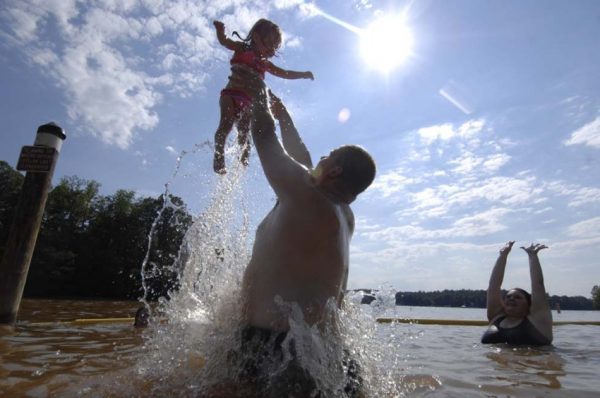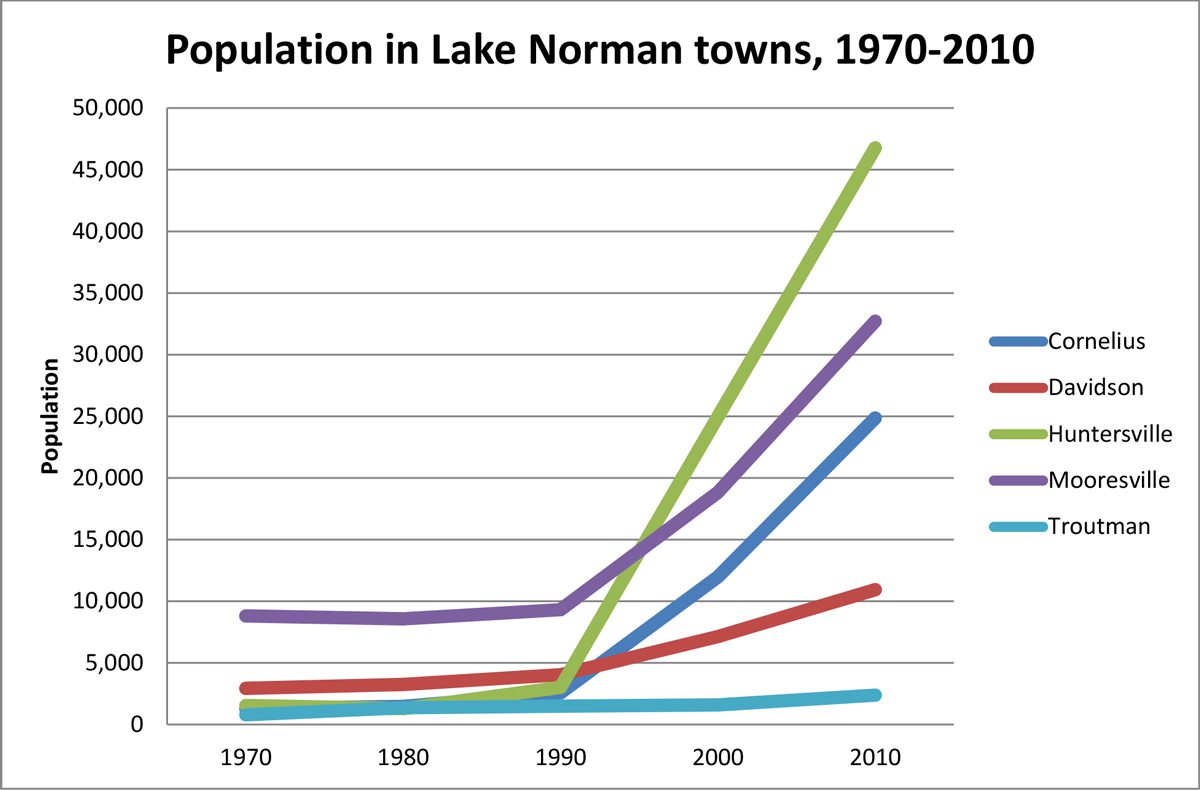Lake Norman’s strange political geography

The following is an excerpt from Chuck McShane’s new book, A History of Lake Norman: Fish Camps to Ferraris, published by the History Press.
Flood plains don’t respect our artificial political boundaries. So when the waters filled up Lake Norman, a 660-acre peninsula of Mecklenburg County just south of the Iredell County line remained dry, but isolated, from the rest of Mecklenburg by acres of water. When officials realized what had happened, Mecklenburg tried to sell the uninhabited land to Iredell. The Iredell commissioners refused, but they offered to take it off Mecklenburg’s hands for free. E.E. Boyer, chair of the Iredell County Commission at the time, said that the uninhabited zone would “cost more to police than it would be worth in tax value.” So there it sat, nicknamed “Meck Neck” and isolated from the rest of the county by a 20-minute circuitous drive. It would take more than 30 years to figure out a solution.
The Lake Norman Marine Commission, in theory, was supposed to direct growth and public safety near the lake. In practice, the governing body had no real law-making powers. The four surrounding counties provided the commission’s budget and often made sudden and swift cuts. The commission managed to provide two safety patrol officers during the 1970s and 1980s, but not much else. Neighborhood activists stepped into the confused fray. Some were concerned environmentalists worried about overtaxed septic systems, eroded shorelines and future water quality. Others were concerned that lake dwellers weren’t getting adequate police and fire protection. Still others were NIMBYs. Those neighbors of the Not-In-My-Backyard persuasion had their piece of the lake and didn’t want anyone else to spoil it by moving next door, certainly not anyone with less money. Never mind that they had just moved there, too.
One of the earliest—and most organized and coherent— neighborhood groups to emerge was Lake Owners Gathered in Concern, or LOGIC, which formed in early 1984. LOGIC saw Lake Norman as a community with its own distinct needs and challenges. Their plan was to make the Lake Norman Marine Commission the sole local authority governing the lake and the surrounding land one mile from shore. The commission would be funded by a special services tax of residents within that jurisdiction. It would regulate zoning, water quality, public safety and wastewater disposal. It was an ambitious plan. The fledgling Lake Norman Magazine opposed the plan, saying the legal hurdles such a plan would face were just too high. The plan would have to receive approval from the state as well as fend off any opposition from local county commissions. When the group invited the Lake Norman Commissioners to meet, only one showed up. Their plan was doomed.

Always present, the issue of public access to the lake re-emerged in the early 1980s. Mecklenburg County had long planned to develop a forty-six-acre lot off Nantz Road into a park. It had been an old boat ramp and was a tree-shaded lot where overheated teenage lovers parked late on Friday nights and grizzled early morning fishermen launched their wooden boats on Saturdays. The park added some playground equipment and a bigger boat ramp. The small beach was off-limits to swimmers because the county wanted to avoid lawsuits over drownings and other accidents. “It’s very difficult to provide lifeguards when you can’t see the bottom of the lake,” said county Parks and Recreation Director Wayne Weston.
People swam there anyway. They swam at some of the original Duke access points now, too. At Pinnacle Point Access Area in Iredell County, 300–400 sunbathers and swimmers crowded near boat ramps, making for dangerously close calls in summer 1984. Iredell County sheriff ’s deputies gave some sunbathers trespassing notices. The deputies arrested some swimmers, booking them into the Statesville jail, with the orange-tinged water still dripping from their bathing suits.
When Holiday Harbor, a popular private marina in Cornelius announced plans to build a large condominium complex, the public access crunch got worse. Holiday Harbor had allowed the public to use the boat launches for a fee. When the condominiums rose, though, the boat slips would become private.
Holiday Harbor owner Jack Bennett said he had good reason to sell to developers. Lakefront land prices had become too high to waste on asphalt, while getting nothing but two dollar launch fees in return.
“The lake is going more and more to permanent housing and a more private atmosphere. You begin with single-family housing residents; they don’t want public access around them. And condo owners don’t want people driving through their areas twenty-four-hours a day. I doubt seriously if there will be any additional public access areas available. The cost and the pressure from residents and zoning would be an issue.”
A Lake Norman Marine Commission member summed up his frustration with the dilemma. “I would like to see more public-access areas. I don’t know whose obligation it would be or where the money would come from, but there’s got to be something to serve the people who don’t have lots up here.”
There was very little the commission, the counties or any other government body could do.
Neighbors who had enjoyed the rural, unregulated nature of the lake when they first moved, now wanted tighter controls on growth. Lincoln County had long fought countywide zoning. In 1985, the only area in that rural county with any sort of zoning at all was the county seat of Lincolnton—far from the lake. When the D.H. Phillips Company proposed 400 condominiums on a 22-acre island, 250 feet from the tip of the Westport neighborhood, the neighborhood group there balked. The Westport Property Owners Association crowded county council meetings to fight the proposal.
“We want to make sure that people with small lots don’t try to build on them and the houses don’t turn into two-family homes,” said association leader Richard Alexander. At the same meeting, other homeowners complained of roaming dogs and hunters firing their guns in nearby woods.
There was an element of NIMBYism in the Westport homeowners’ objections. Some of their concerns, though, were legitimate. While issues like public access to the lake and density of new subdivisions divided lakeside residents, one universal issue united them. Far from any municipal sewer systems, the soft soils of the lakebed were pocked with holes containing septic tanks and smaller private neighborhood sewage treatment plans. Overflowing and aging septic tanks could send unpleasant odors and potentially dangerous bacteria into the soil around the coves. Loosely regulated private plants could malfunction, discharging thousands of gallons of untreated effluent into the rapidly developing coves.
Occasionally, things got bad enough for no swimming advisories. Fortunately, the lake was large enough to dilute most of the pollution.Unlike some areas downriver on the Catawba, the Lake Norman area had no paper mills, chemical plants or any other heavy industry, aside from the Marshall Steam Station in Terrell. Looking toward the future, though, local fishermen and elected officials were worried, and they lobbied for the extension of municipal and countywide systems.
“They can claim 90 percent efficiency for some of those [package plant] systems,” a Catawba County Commissioner said in 1985. “But that means 10 [percent] of the waste is still getting into the lake.”
A History of Lake Norman: Fish Camps to Ferraris is available at bookstores in the Charlotte area and online. For more excerpts, a book talk schedule and discussions about Lake Norman history, visit the book’s Facebook page.